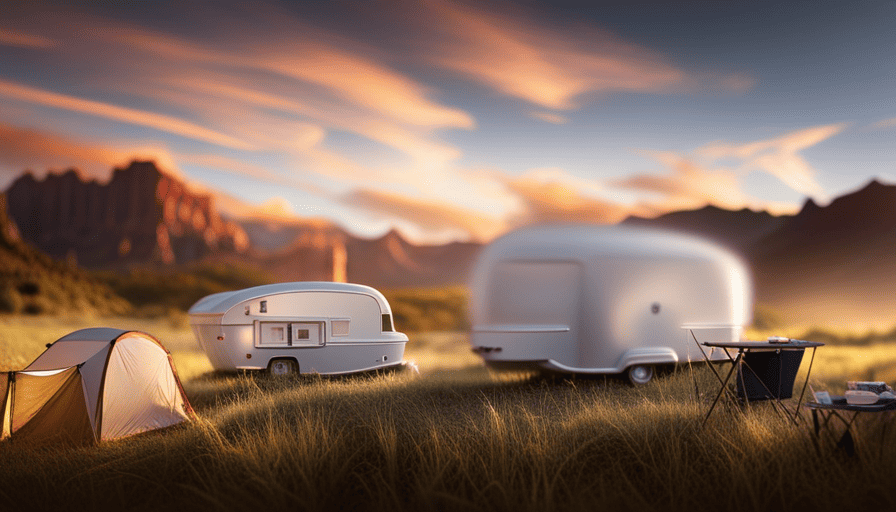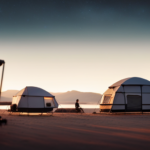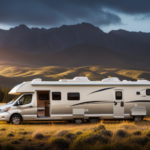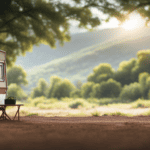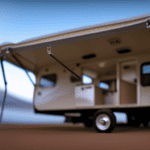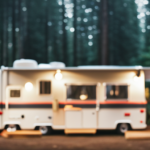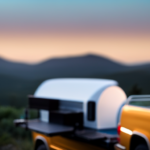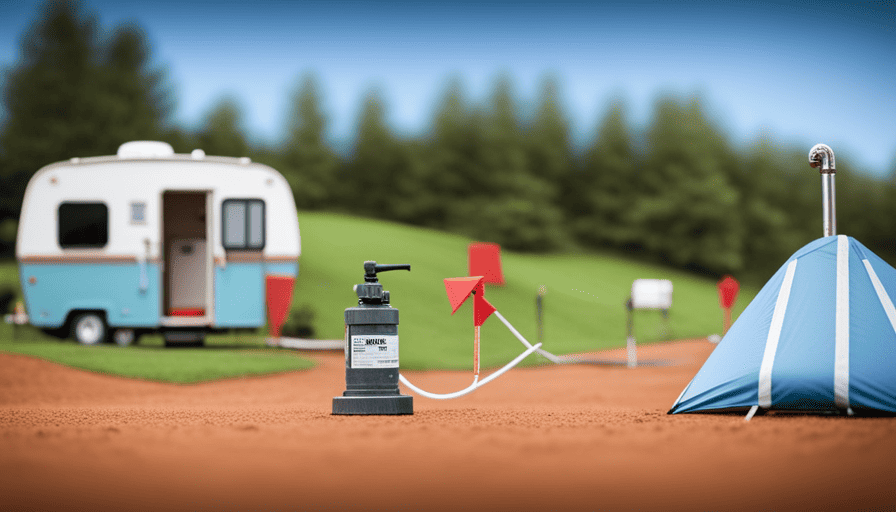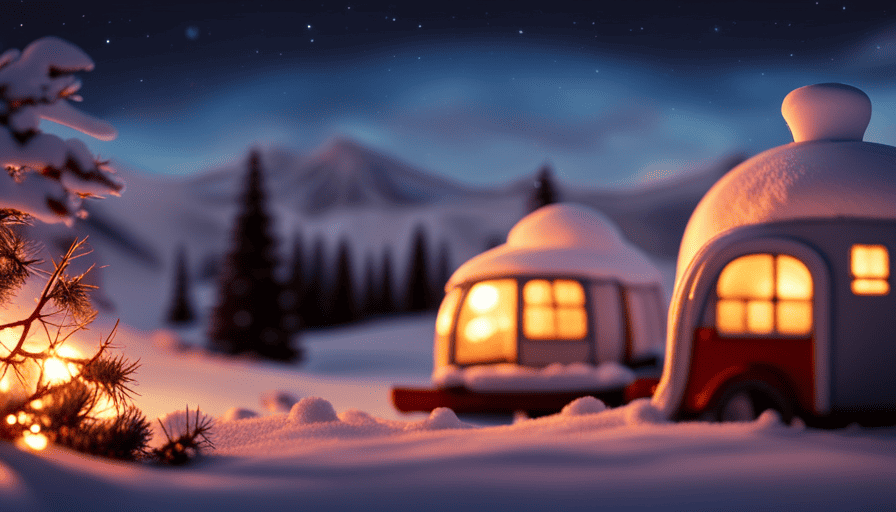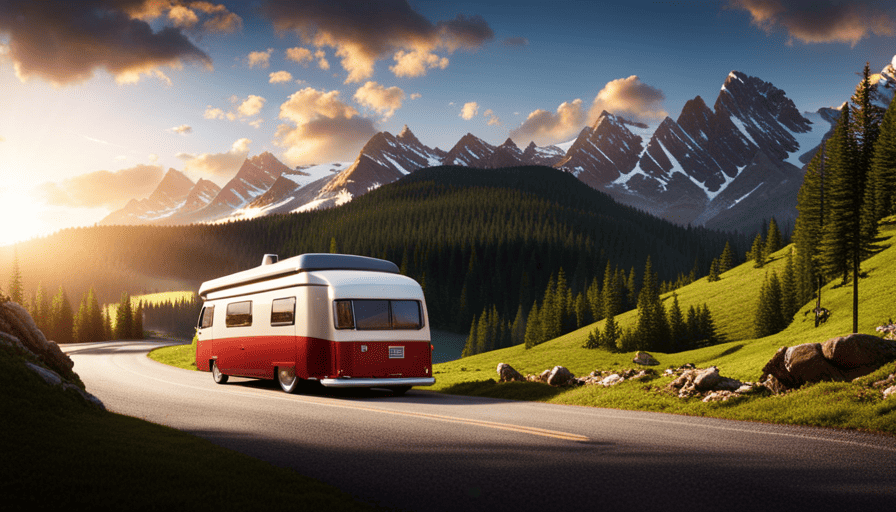Imagine a pop-up camper as a versatile jack-in-the-box, ready to expand and transform into a cozy home wherever you go. Like a chameleon, it seamlessly blends in with its surroundings during the day and becomes a comforting retreat at night.
In this article, I will take you on a journey to uncover the inner workings of a pop up camper. From its collapsible walls and roof to its lifting mechanisms and bed configurations, we will explore every detail that makes these campers a popular choice for outdoor enthusiasts. We will also delve into the different types of pop up camper weight specs and how they can impact the towing capacity of different vehicles. Understanding the weight specifications of a pop up camper is crucial for ensuring safe and secure towing, so we will break down the different weight categories and what they mean for your camping experience. By the end of this article, you will have a comprehensive understanding of what makes a pop up camper tick and how to choose the right one for your outdoor adventures.
We will also delve into the kitchen and dining area, storage solutions, electrical and plumbing systems, as well as climate control options.
Finally, I will provide you with some essential maintenance and care tips to ensure your pop up camper remains in top shape for many adventures to come.
So, let’s dive in and discover how a pop up camper works!
Key Takeaways
- Pop up campers are versatile and cozy, providing a comfortable sanctuary away from home.
- They have collapsible walls and roofs, allowing for easy expansion and contraction.
- Pop up campers are made from durable and weather-resistant materials like fiberglass or canvas.
- They are lightweight and easy to tow and maneuver, making them convenient for travel.
Basic Structure and Design
Now let’s take a closer look at how you’ll be able to easily set up and take down your pop up camper using its simple and convenient design.
One important aspect to consider is weight distribution. Pop up campers are designed with a lightweight frame and materials to ensure easy towing and maneuverability. The weight is evenly distributed throughout the camper, making it stable on the road and preventing any swaying or wobbling. This ensures a smooth and safe journey to your destination.
Another key factor in the design of a pop up camper is material selection. The exterior walls and roof are typically made of durable and weather-resistant materials such as fiberglass or canvas. These materials are chosen for their ability to withstand various weather conditions and provide adequate insulation. The lightweight nature of these materials also contributes to the overall ease of setup and takedown.
Moving on to the next section about collapsible walls and roof, the pop up camper’s design allows for easy expansion and contraction. With just a few simple steps, the walls and roof can be collapsed or extended, providing ample space for sleeping, dining, and relaxing.
Collapsible Walls and Roof
When you collapse the walls and roof of a pop-up camper, it’s like folding a delicate origami masterpiece. The collapsible walls and roof are key features that make pop-up campers so unique and convenient.
These walls are typically made of a sturdy and weather-resistant material, such as canvas or vinyl, which helps to protect against the elements. This means that even if it starts raining during your camping trip, you can easily close up the camper and stay dry inside.
The collapsible design also contributes to the ease of setup. When you arrive at your campsite, all you need to do is unfold the walls and roof, and you have an instant living space. It’s as simple as that! And when it’s time to pack up and go home, collapsing the walls and roof is just as easy. You can quickly fold everything down into a compact size, making it much easier to transport and store.
Now, let’s move on to the lifting mechanisms that are used in pop-up campers.
Lifting Mechanisms
The ingenious lifting mechanisms in pop-up campers effortlessly elevate the walls and roof, transforming a compact package into a spacious and cozy living space. There are two main types of lifting mechanisms used in pop-up campers: hydraulic and manual.
Hydraulic lifting mechanisms use hydraulic cylinders to raise and lower the camper’s walls and roof. This type of mechanism is powered by a hydraulic pump, which pressurizes hydraulic fluid and transfers the pressure to the cylinders. With just the push of a button, the walls and roof can be lifted or lowered effortlessly, making setup and teardown quick and easy.
On the other hand, manual lifting mechanisms require physical effort to raise and lower the walls and roof. These mechanisms often involve the use of cranks or winches that are operated by hand. While manual lifting may require more effort, it can still be done relatively easily by one or two people.
Overall, the lifting mechanisms in pop-up campers are designed to be user-friendly and efficient. They allow campers to quickly and effortlessly transform their compact trailers into comfortable living spaces.
In the next section, we will explore the different bed configurations available in pop-up campers, which further enhance their versatility and functionality.
Bed Configurations
One of the most exciting features of pop-up campers is their versatile bed configurations. These campers are designed to maximize sleeping space while still providing comfort and convenience.
One popular bed configuration is the slide out beds. These beds are typically located on the sides of the camper and can be easily extended or retracted when needed. This allows for additional sleeping space without sacrificing the living area of the camper.
Another common bed configuration is the bunk options. These beds are usually located at the rear or front of the camper and are stacked on top of each other. Bunk beds are a great option for families or larger groups who need multiple sleeping areas. They’re also great for maximizing space in smaller campers.
With these various bed configurations, pop-up campers offer flexibility and comfort for all types of camping adventures.
Moving on to the next section, the kitchen and dining area provides essential amenities for cooking and eating on the go.
Kitchen and Dining Area
Get ready to experience the convenience and joy of cooking and dining on the go in your pop-up camper’s kitchen and dining area. The space-saving design of these areas ensures that you can make the most of the limited space available. The kitchen is equipped with all the essential cooking appliances you need to whip up delicious meals while on your adventures.
In the kitchen, you’ll find a compact stove with multiple burners, allowing you to cook multiple dishes simultaneously. The sink is also conveniently placed nearby, making it easy to clean up after meals. Additionally, there is a small refrigerator to store perishable items and keep your food fresh.
The dining area provides a cozy spot to enjoy your meals. It typically consists of a foldable table and comfortable seating for the whole family. The table can be easily set up and taken down when needed, maximizing the available space.
To give you a better idea of the layout, here’s a table that illustrates the kitchen and dining area:
| Kitchen | Dining Area |
|---|---|
| Compact stove | Foldable table |
| Sink | Comfortable seats |
| Small refrigerator |
With the kitchen and dining area in your pop-up camper, you can enjoy home-cooked meals and create lasting memories with your loved ones. Next, we’ll explore the bathroom facilities available in these campers.
Bathroom Facilities
Imagine the convenience of having a fully functional bathroom right in your compact camper. When it comes to bathroom facilities in a pop-up camper, there are a few options available.
One common feature is a portable toilet, which is compact and easy to use. These toilets are designed to be easily emptied and cleaned, making them a practical choice for camping trips.
Some pop-up campers also come equipped with a shower option. These showers are typically small and compact, but they provide the convenience of being able to freshen up while on the road.
Whether you’re using the portable toilet or taking a quick shower, having these bathroom facilities in your pop-up camper adds a whole new level of comfort and convenience to your camping experience.
Now, let’s talk about storage solutions.
Storage Solutions
Now that we’ve discussed the bathroom facilities in a pop-up camper, let’s move on to another important aspect of these campers – storage solutions. When you’re out on the road, it’s essential to have a well-organized space to store all your belongings, and pop-up campers offer some clever solutions to make the most of the limited space available.
-
Utilize vertical space: One of the best organization tips is to think vertically. Install shelves or hanging organizers on the walls to maximize storage capacity without taking up valuable floor space.
-
Opt for multipurpose furniture: Look for furniture pieces that serve multiple functions. For example, choose a dining table that can also be converted into a bed or a storage ottoman that can store extra blankets and pillows.
-
Use storage bins and containers: Invest in storage bins and containers that can fit in the small nooks and crannies of your camper. These will help keep your belongings organized and prevent them from shifting during travel.
By implementing these space-saving hacks, you can ensure that every inch of your pop-up camper is utilized efficiently.
Now, let’s move on to the next section, where we’ll explore the electrical and plumbing systems of these campers.
Electrical and Plumbing Systems
With the flip of a switch, the electrical and plumbing systems in a pop-up camper bring comfort and convenience to your outdoor adventures. These systems are designed to provide you with a reliable water supply and efficient waste disposal, making your camping experience more enjoyable.
The water supply in a pop-up camper is typically provided by a freshwater tank. This tank can be filled up before your trip and will provide you with running water for cooking, cleaning, and showering. Some pop-up campers also have a water heater, allowing you to enjoy hot showers even when you’re out in the wilderness.
When it comes to waste disposal, pop-up campers usually have a built-in toilet and a black water tank. This tank collects all the waste from the toilet and can be emptied at designated dumping stations. It’s important to properly maintain and clean the tank to prevent any unpleasant odors or leaks.
Transitioning into the next section, climate control options are also available in pop-up campers to ensure your comfort in any weather condition.
Climate Control Options
You’ll be delighted to know that there are various climate control options available in these nifty campers to keep you cozy and comfortable, no matter the weather. When it comes to staying warm, portable heaters are a popular choice among campers. These compact devices are easy to use and can quickly heat up the interior of your pop-up camper. They typically run on propane and have safety features such as automatic shut-off in case of tipping or low oxygen levels.
On the other hand, if you’re camping in hot weather, air conditioning units can be a lifesaver. These units are designed to fit in the windows or roof vents of your camper and provide cool air during those scorching summer days. They usually run on electricity and may require a generator or shore power hookup.
To help you compare the different options, here’s a handy table showcasing the features of portable heaters and air conditioning units:
| Climate Control Option | Features |
|---|---|
| Portable Heaters | – Compact and easy to use |
| – Run on propane | |
| – Safety features included | |
| Air Conditioning Units | – Fit in windows or roof vents |
| – Provide cool air | |
| – Require electricity |
Now that you know how to keep your camper’s climate under control, let’s move on to some maintenance and care tips to ensure your pop-up camper stays in top shape.
Maintenance and Care Tips
Taking proper care of your camper is essential to ensure its longevity and optimal performance. Maintenance and care are crucial aspects of owning a pop-up camper. To help you keep your camper in top shape, here are some troubleshooting tips and cleaning techniques.
Regularly inspect your camper for any signs of wear and tear. Check the roof, walls, and seams for leaks or damage. Address any issues promptly to prevent further damage. Lubricate the moving parts, such as hinges and slide-out mechanisms, to keep them functioning smoothly.
Cleaning your camper is also important to maintain its appearance and functionality. Start by thoroughly cleaning the exterior using a mild detergent and water. Pay special attention to the roof, as it can accumulate dirt and debris. Inspect and clean the awning, ensuring it’s dry before retracting it.
Inside the camper, clean the floors, countertops, and upholstery regularly. Use a vacuum cleaner or broom to remove dirt and debris. For stains, use appropriate cleaning products based on the material.
To prevent mold and mildew growth, ensure proper ventilation by opening windows and using fans. It’s also recommended to use dehumidifiers or moisture absorbers in humid climates.
By following these maintenance and cleaning techniques, you can extend the lifespan of your pop-up camper and enjoy many memorable camping adventures.
Frequently Asked Questions
Can a pop-up camper be used in extreme weather conditions?
In extreme weather conditions, using a pop-up camper can be quite challenging. While it may provide some shelter, it isn’t designed to withstand harsh elements like heavy rain, strong winds, or extreme temperatures. The canvas walls and lightweight construction make it susceptible to leaks, tears, and damage. However, if properly prepared and used in moderate weather conditions, a pop-up camper can still offer convenience and comfort for outdoor adventures.
How long does it take to set up and take down a pop-up camper?
Setting up and taking down a pop-up camper typically takes around 30 minutes to an hour, depending on your experience and familiarity with the process. When setting up, you’ll need to unfold the camper, extend the stabilizing legs, and secure any awnings or additional features.
Taking it down involves retracting the legs, folding the camper, and stowing it away in its designated storage area. Properly maintaining and organizing the camper’s storage requirements is crucial for a smooth setup and takedown process.
Are pop-up campers suitable for families with young children?
Pop-up campers are a fantastic option for families with young children. They offer a safe and cozy space for everyone to enjoy the great outdoors together. With proper safety measures in place, like sturdy bed rails and secure latches, parents can have peace of mind.
Plus, pop-up campers often come with clever storage solutions to keep all your gear organized. So, whether it’s a family adventure or a weekend getaway, pop-up campers are a perfect fit for making lasting memories.
Can a pop-up camper be towed by a small car?
Yes, a pop-up camper can be towed by a small car, but it’s important to consider the weight and towing capacity. Pop-up campers typically weigh between 1,000 to 3,000 pounds, so it’s crucial to check your car’s towing capacity before attempting to tow one. Be sure to consult your car’s manual or contact the manufacturer to ensure that your vehicle is equipped to safely tow the weight of a pop-up camper.
Are pop-up campers allowed in all campgrounds and RV parks?
Pop-up campers are generally allowed in most campgrounds and RV parks, but it’s important to check the specific regulations of each location. Many campgrounds have size restrictions and may require a reservation for larger pop-up campers.
The benefits of using a pop-up camper in campgrounds and RV parks include their compact size, easy setup, and affordability. They provide a comfortable and convenient camping experience while still allowing you to enjoy the great outdoors.
Why Does My Pop Up Camper Shake When I Walk Inside?
A common issue that campers experience is when their camping trailer shakes while walking inside. This phenomenon can be attributed to various factors such as uneven terrain, loose stabilizer jacks, or weak suspension. To address this problem, it is crucial to inspect and tighten any loose components, level your camping trailer properly, and consider upgrading its suspension system if needed. Ensuring a stable and comfortable experience inside your pop-up camper is essential for an enjoyable camping trip.
Conclusion
In conclusion, the inner workings of a pop up camper are truly fascinating. From its collapsible walls and roof to the lifting mechanisms that make it all possible, every aspect of this clever design is worth exploring.
With its various bed configurations, kitchen and dining area, and storage solutions, a pop up camper offers a comfortable and convenient camping experience. Additionally, its electrical and plumbing systems, along with climate control options, provide all the necessary comforts of home.
By following proper maintenance and care tips, you can ensure that your pop up camper lasts for many memorable adventures to come.

